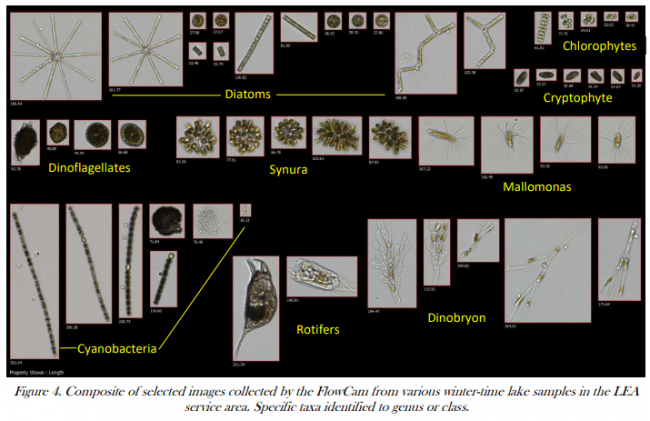
May – LEA’s water testing team collected the first fluorometer profile in late May. At that time, mild stratification had just started to form in the very deepest waters. In the upper waters, fluorescence values increased until reaching their peak at 2 meters where plenty of sunlight was available for photosynthesis. In the middle and deep waters fluorescence values remained fairly uniform. Increased fluorescence values near the bottom are likely caused by interference from bottom sediments.
June – In the upper waters, fluorescence values gradually increased until again reaching a peak at 2 meters. In the middle and deep waters, fluorescence values remained uniform throughout the rest of the water column. increased fluorescence values near the bottom are likely caused by interference from bottom sediments.
July – In the upper waters, fluorescence values increased until reaching their peak at 3 meters. This is likely where the colder, denser water provided algae a place to “sit”. In the middle waters fluorescence values gradually decreased. There was only minor variability in fluorescence throughout the deep waters. The spike in values at the bottom was likely caused by sediment interference.
August – Fluorescence values were highest in the upper waters and reached a peak at 3 meters. Below the peak, algae concentrations gradually decreased. In the bottom waters, fluorescence values were low and remained uniform.
September – In the upper waters, fluorescence values gradually increased until reaching a very mild peak at 3 meters. In the middle waters fluorescence values gradually decreased and then they remained uniform throughout the deep waters.
Synopsis: Algae concentrations were low to moderate throughout the water column and the season. The highest (but still moderate) readings were found at 3 meters in depth and then moved down to 4 meters in depth as the season progressed. High readings in the bottom waters were likely caused by sediment interference.
Gloeotrichia echinulata (a type of cyanobacteria (blue-green algae) commonly found in low-nutrient waters) can be seen with the naked eye. Gloeo density is reported as a value ranging from 0 – 6, based on the number of Gloeo colonies seen through a Secchi scope. Higher values indicate more Gloeo colonies. McWain Pond’s Gloeotrichia echenulata density ranged from 0 through 1 with the highest density occurring in mid-August.

